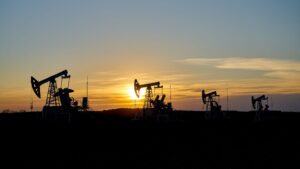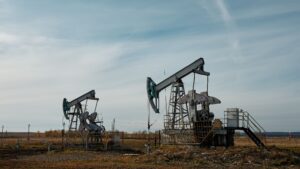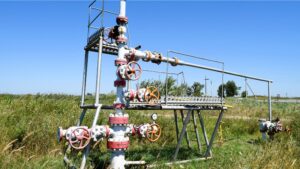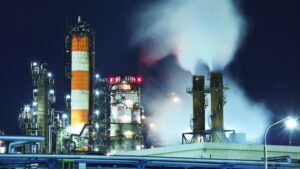Oil and gas production stands as the backbone of the global energy sector, often referred to as the lifeblood of modern civilization. Responsible for powering various sectors, from transport to manufacturing, oil and gas are the key players in the world’s energy matrix.
In this article, we delve into the intricate processes involved in oil and gas production, the industry’s historical context, significance, techniques, environmental impacts, safety measures, and future prospects in the face of a greening industry.
What is oil and gas production?
At its core, oil and gas production is a series of processes aimed at extracting, refining, and distributing crude oil and natural gas from subsurface reservoirs to consumers worldwide.
These processes, broadly categorized into upstream, midstream, and downstream stages, involve a range of activities from exploration and drilling to refining and marketing of the finished products.
The oil and gas industry, a significant pillar of many economies, has deep impacts on national revenue, job creation, and global energy security. However, the intricate operations necessitate robust regulatory measures, advanced machinery, and the constant application of new technologies to balance efficiency, safety, and environmental considerations.
Short history of oil and gas production
The history of oil and gas production is a fascinating chronicle marked by discovery, innovation, and influence on global politics.
The inception of commercial oil drilling traces back to the mid-19th century with Edwin Drake’s well in Pennsylvania, marking the advent of the modern petroleum industry. In contrast, natural gas was first commercialized in Britain in the early 19th century, primarily for lighting.
Over the centuries, the industry has witnessed dramatic advancements in extraction techniques, equipment, and safety measures.
The 20th century marked the discovery of vast oil reserves in the Middle East, reshaping the geopolitical and economic landscapes.
The turn of the 21st century has brought further complexities, with growing environmental concerns and the emergence of renewable energy sources challenging traditional oil and gas production practices.
What is the importance and purpose of oil and gas production?
Oil and gas production plays a pivotal role in sustaining global economies and ensuring energy security. The industry contributes significantly to national incomes, particularly in countries with large reserves, such as Saudi Arabia, Russia, and the United States.
For example, Saudi Arabia, the largest exporter of petroleum, derives around 90% of its revenue from oil. In contrast, the U.S. oil and gas industry supports over 10 million jobs, demonstrating the sector’s immense influence on employment.
Fluctuations in oil prices can resonate through global markets due to the industry’s interconnectivity with other sectors. For instance, the oil price crash of 2014 severely impacted economies reliant on oil revenues, underscoring the industry’s susceptibility to market dynamics.
From a geographical perspective, the world’s oil and gas reserves are unevenly distributed, leading to a complex geopolitical tapestry.
Venezuela, Saudi Arabia, and Canada boast the largest oil reserves, while Russia, Iran, and Qatar lead in natural gas reserves. The possession of these reserves often translates into significant political leverage, impacting international relations and trade policies.
How are mineral rights and oil and gas production connected?
Mineral rights are a critical facet of oil and gas production, representing legal entitlements to explore and extract mineral resources, including oil and gas, from a specific tract of land.
They often form the basis for the development of new extraction sites, enabling companies or individuals to access the resources beneath the property’s surface. The owner of these rights may sell, lease, or transfer them, creating an opportunity for oil and gas companies to negotiate for these rights and establish productive operations.
Securing mineral rights provides companies with the legal permission to drill and extract, promoting responsible and regulated development of these resources. They form the foundational legal structure that supports the exploration, extraction, and eventual delivery of these resources to the marketplace.
What are the different stages of oil and gas production?
Oil and gas production operates within a value chain encompassing three primary stages: upstream, midstream, and downstream.
The extraction and use of oil and gas, as critical energy sources, involve a multi-staged, complex process. Each stage is essential in converting these natural resources into usable end products, from heating homes to fueling transportation systems. Understanding this procedure helps in appreciating how oil and gas power our world today.
Commencing with Upstream Operations
The upstream oil and gas stage, also known as the exploration and production (E&P) sector, serves as the foundation for the entire oil and gas production process. Here, the resources are located and extracted from beneath the earth’s surface.
- Exploration: This is the initial phase of the upstream stage. It involves identifying potential oil and gas reserves using various geological and geophysical methods, including seismic surveys and satellite imaging. The aim is to find reservoirs that contain economically viable volumes of oil or gas.
- Drilling: Following successful exploration, the drilling phase begins. Specialized drilling rigs bore wells into the identified reservoirs to access the oil or gas trapped below. This process can occur on land (onshore) or at sea (offshore), depending on the location of the reserves.
- Extraction: The last part of the upstream stage is extraction. Here, the oil or gas is drawn to the surface from the well. In some instances, secondary recovery methods may be employed, such as injecting water or gas into the well, to maximize extraction.
Transitioning through Midstream Operations
Midstream oil and gas operations form the link between the extraction of raw materials and the delivery of usable products. It’s a bridge that involves processing, storing, and transporting oil and gas.
- Processing: The raw output from extraction often contains impurities and several hydrocarbons that need to be separated. This is achieved in the processing phase, where the oil or gas is treated to meet market specifications.
- Storing: After processing, the oil and gas are stored in specially designed tanks or facilities. Storing ensures these resources are safely kept until they’re ready to be transported to various locations for refining.
- Transportation: This phase involves moving the oil and gas from extraction sites to refineries and processing plants. Depending on the distance and infrastructure, transportation may occur via pipelines, trucks, or tanker ships.
Concluding with Downstream Operations
The downstream oil and gas stage is where oil and gas are converted into end products for consumer and industrial use. This stage also involves the sale and distribution of these products.
- Refining: In this phase, crude oil is transformed into a wide variety of products. These include gasoline, diesel, jet fuel, heating oil, and asphalt. Natural gas, on the other hand, is treated to produce products such as ethane, propane, and butane.
- Distribution: The final step in the oil and gas production process is distribution. This phase involves selling and delivering the products to consumers, businesses, and industries. It includes gasoline stations, home heating providers, power plants, and petrochemical companies, among others.
What is an Integrated Oil and Gas Production Company?
Integrated oil and gas companies operate across all three stages of the production process.
They explore and extract oil and gas, process and transport these products, and finally, refine and distribute them to consumers. This vertical integration allows these companies to control a wide spectrum of operations, enhancing efficiency and profitability.
Some of the major integrated oil and gas companies include ExxonMobil, Chevron, and BP.
What are the machines and tools required for oil and gas production?
Oil and gas production relies heavily on an array of machinery and equipment.
Some of these essential tools are:
- Drilling rigs: Used to drill wells into the earth’s crust to extract oil and gas.
- Pipelines: Transport oil and gas from the extraction site to processing facilities and refineries.
- Storage tanks: Store oil and gas safely during different production stages.
- Pumping units: Lift oil out of wells when natural pressure isn’t sufficient.
- Separators: Separate oil, gas, water, and sand during extraction.
- Compressors: Compress natural gas to reduce its volume for easy transportation.
- Refinery units: Convert crude oil into various products like gasoline and jet fuel.
- LNG plants: Process natural gas into liquefied natural gas for transportation and storage.
What are the Different Methods and Techniques used in oil and gas production?
Oil and gas production employs various methods and techniques, each tailored to specific reservoir conditions and economic considerations. Traditional methods like primary recovery rely on natural pressures in the reservoir to drive oil and gas to the surface. However, these methods often leave a significant amount of oil and gas in the reservoir.
Advanced techniques like secondary and tertiary recovery (or enhanced oil recovery, EOR) are employed to maximize extraction.
- Secondary recovery involves injecting water or gas into the reservoir to maintain pressure and push more oil toward the well. EOR techniques include gas injection, thermal recovery, and chemical injection, which can significantly increase the field’s productivity.
- Hydraulic fracturing, or fracking, has emerged as a game-changing technique to extract oil and gas from unconventional reserves like shale formations. It involves injecting high-pressure fluid into the reservoir to create fractures, allowing oil or gas to flow more freely to the well.
What are the Benefits of Oil and Gas Production?
Oil and gas production plays an instrumental role in numerous facets of human life and societal development. It influences aspects that stretch from daily conveniences to global economic stability.
These fossil fuels, often dubbed “black gold,” play a key role in fueling our modern world.
- A majority of transportation means, such as cars, trucks, airplanes, and ships, predominantly depend on the power derived from these resources.
- Moreover, they provide raw materials for an array of products like plastics, fertilizers, detergents, and even pharmaceuticals. Consequently, this sector presents an indispensable influence on various other industries and the global economy.
- On the economic front, oil and gas production drives job creation, investment opportunities, and significant revenue streams. Countries like Saudi Arabia, Russia, and the United States, with large reserves, have seen their economies significantly shaped by these industries.
The magnitude of this influence is such that fluctuations in oil and gas prices can cause ripples in global markets.
Furthermore, oil and gas production provides a substantial part of government revenues, particularly in oil-rich nations.
These revenues, often termed “petrodollars,” fund public services, infrastructure projects, and even social welfare programs.
It’s vital to acknowledge that the benefits of oil and gas production are not without their challenges and criticisms, especially regarding environmental implications. Nevertheless, the industry’s ongoing efforts to tackle these concerns through cleaner technologies, stricter regulations, and renewable energy investments illustrate its essentiality in our present world.
What is the Environmental Impact of Oil and Gas Production?
The environmental footprint of oil and gas production is one of the most scrutinized aspects of the industry. It’s largely associated with greenhouse gas emissions, air and water pollution, and the potential for damaging spills or accidents.
The extraction, refining, and burning of these fossil fuels release significant amounts of carbon dioxide and methane into the atmosphere, contributing to climate change. In addition, the extraction process can lead to water contamination if not carefully managed, impacting both human health and the wider environment.
However, the industry has been working towards mitigating these impacts.
For instance, there’s a growing commitment to carbon capture, utilization, and storage (CCUS) initiatives. These technologies aim to capture carbon dioxide emissions from oil and gas production, preventing them from reaching the atmosphere.
Stricter regulations are also being implemented to reduce the environmental footprint of the industry.
This includes the use of cleaner technologies, such as more efficient drilling techniques and improved spill prevention measures.
Moreover, many companies in the sector are also diversifying their energy portfolios, investing in renewable sources like wind and solar power. This shift aligns with the Paris Agreement goals and signifies a crucial stride towards a greener energy future.
Is Oil and Gas Production Expensive?
The costs associated with oil and gas production can vary greatly depending on various factors.
This includes:
- geographical location of reserves
- the complexity of extraction methods
- market conditions
- regulatory frameworks
Exploration and drilling processes, which constitute the initial stages of production, are often the most costly. They involve complex and expensive technologies, such as seismic surveys and drilling rigs, and can take years before any oil or gas is actually produced.
Moreover, the costs also encompass the operations of processing, storing, and transporting the extracted resources to the refineries and then to the consumers. Additionally, companies have to factor in expenses related to regulatory compliance, worker safety measures, and environmental mitigation strategies.
Despite these costs, the potential for high returns makes oil and gas production a lucrative business for many companies. However, it’s a sector that can be significantly influenced by external factors, including fluctuating commodity prices, geopolitical events, and increasingly, climate policy.
Safety and Regulations in the Oil and Gas Production
Safety and adherence to regulations are pivotal components of oil and gas production. These aspects primarily concern the well-being of the workforce, the integrity of the environment, and the prevention of disastrous accidents.
The industry’s workforce is exposed to a range of potential hazards, including explosive gases, flammable liquids, high-pressure machinery, and physically demanding work environments. As a result, stringent safety protocols are in place to protect workers, with regular training, safety equipment, and continual monitoring of working conditions being paramount.
On the environmental front, regulations are in place to minimize the impact of extraction and production activities. These may include requirements for waste disposal, emission levels, water usage, and habitat protection. Compliance with these standards is not just a legal necessity but also crucial for maintaining a company’s social license to operate.
Finally, the industry also has robust systems to prevent major accidents such as oil spills or gas leaks. This includes stringent design and operational standards for drilling rigs and pipelines, regular equipment checks, and emergency response plans.
These regulations and standards, however, do not eradicate the risks entirely, and the industry continuously strives for improvement in safety measures and environmental stewardship.
Modern and Future Technologies in the Oil and Gas Production
In a bid to increase efficiency, reduce costs, and minimize environmental impact, the oil and gas sector is increasingly turning to innovative technologies. Some of these technological advancements include artificial intelligence, big data analytics, the Internet of Things (IoT), and drones.
- Artificial Intelligence (AI) is revolutionizing many aspects of the industry. AI can assist in reservoir valuation, machinery condition monitoring, and even customized drilling plans. It improves efficiency, reduces human error, and leads to cost savings.
- Big Data Analytics enables companies to collect, store, and analyze vast amounts of data to inform decision-making. For instance, it can aid in identifying optimal drilling locations or predicting machinery maintenance needs, enhancing operational efficiency.
- The Internet of Things (IoT) is a network of connected devices and sensors, that enable real-time monitoring and data collection across various operations. This aids in managing operations efficiently, promoting better field communication, and reducing downtime.
- Drones offer high-level visibility of wells, storage areas, and facilities, which speeds up daily evaluations and ensures assessment accuracy. They can reach remote and challenging locations, providing critical data without putting human lives at risk.
These technologies are not only propelling the industry towards higher efficiency and safety standards but also driving it towards a more sustainable future.
Oil and Gas Production and the Green Industry
The global energy landscape is evolving, and the shift toward renewable energy sources poses both challenges and opportunities for the oil and gas industry. The mounting pressure to mitigate climate change, the falling costs of renewables, and the changing regulatory landscape are influencing the industry’s dynamics.
In response, many oil and gas companies are diversifying their energy portfolios, investing in renewable technologies like wind, solar, and biofuels. They are also exploring green technologies such as carbon capture and storage (CCS), hydrogen power, and advanced biofuels.
These efforts reflect the sector’s growing commitment to transition towards a lower-carbon future and align with the broader global energy transition.
Oil and gas companies are uniquely positioned to contribute to this energy transition. They possess significant capital, substantial infrastructure, and technical expertise, all of which are crucial for scaling up renewable technologies and green innovations.
Moreover, the industry is increasingly focusing on improving the efficiency of existing operations and reducing their environmental footprint. This includes steps such as implementing energy-efficient technologies, reducing flaring and venting of gas, and improving water and waste management.
Finally, the sector is also playing a role in advancing the circular economy, where resources are used more efficiently and waste is minimized. This includes efforts to recycle or repurpose waste products, integrate renewables into operations, and develop bio-based products.
Bottom Line
In conclusion, while oil and gas production has historically been a significant source of environmental concern, the industry is progressively shifting towards greener practices and technologies.
This transition not only presents an opportunity for the sector to mitigate its environmental impact but also to play a pivotal role in the broader global shift towards sustainable energy.









Leave a Reply